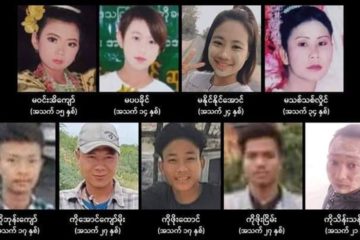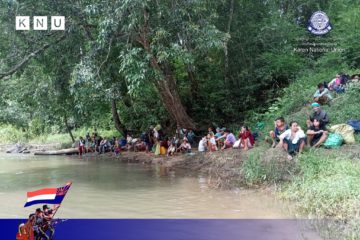
WHAT HAPPENS ON A D-DAY
Today, September 7th, Duwa Dashi La, the acting president of the National Unity Government of Myanmar (the civilian government that opposes the military regime), launched a “People’s defensive war against the military junta.
We’ve been hearing about “D-Day” for months, since the day the People’s Defence Force (PDF) was born, and although it was clear that this day was coming, waking up this morning was a bit of a shock.
But what is a D-Day? And why today?
With the coalition of PDF and various ethnic armed organizations (EAO) opposing the Tatmadaw, just like the Allies did against the Nazis, it’s easy to see why the term D-Day has been so widely used in Myanmar. D-Day is the day when the end of the regime started.
But this is no WWII, and it’s no operation Overlord. The asymmetry in weaponry between the two opposing forces is huge. The Tatmadaw spent 7 decades trying to get stronger and stronger, while the armed resistance, especially in central Myanmar, was non-existent only few months ago. This is more of a general uprising with the vast majority of Myanmar people trying to take General Min Aung Hlaing’s regime down. The will of the people should not be underestimated.
Some evidences to be confirmed, seem to suggest that resistance fighters found some ways to produce weapons and ammunitions. It’s hard to think they can count on these alone though.
The timing of the announcement is interesting. As anything in Myanmar, some numerology is involved for sure. 7 months after the coup, on the 7th day of September (the 7th month of the Roman year), it’s hard not to notice that. Plus, “7” is considered a lucky number.
But most realistically NUG thought this was the right window to launch the revolt. Although I am purely speculating, there may be many factors that brought to this decision.
1) Diplomacy failed: the people of Myanmar have been waiting for a peaceful solution for months, but there is no sign of it. It’s obvious that a large part of the population is not willing to let the military coup succeed, and the only way the Tatmadaw is able to exercise some authority is through brutal force. People have been protesting peacefully and calling for external help for months, and the result is over 1000 victims and 7000 arrests. Besides some strong condemnations by western countries, there was no strong initiative by anyone. The UN has been incredibly passive, waiting for regional powers like ASEAN and China to finally exercise their influence on Myanmar. China, as always, values stability and profit the most, and is using the coup to advance its projects in the region. ASEAN has never engaged with NUG, proving that it has no interest in supporting the democratic movement in Myanmar. It only engaged with the regime. After all, countries like Thailand, Cambodia, Vietnam, Laos and Singapore are not what we would call democratic countries. Just few hours earlier ASEAN, through its special envoy, announced that the Junta accepted its proposal of a humanitarian ceasefire. But the move is seen as a way to help the Tatmadaw reorganize and restock to then attack the opposition even more strongly. Moreover, the Junta has never respected a ceasefire. NUG, so far has been ignored by all important regional actors and clearly thinks diplomacy will not work until it is in a position of strength.
2) The battle for recognition: the UN General Assembly is near, and the battle for who gets recognition as the legitimate government of Myanmar is open. It’s very unlikely that the military regime gets recognition so soon, after seizing power through a coup and violent political repression. At the same time NUG stands very little chances too. Although it is clearly the legitimate government of the country, it lacks territory control, and that matters. The best NUG can hope for right now, is for the UN to decide to not decide. NUG probably decided to show that the Tatmadaw has no control over Myanmar as well. The longer the Tatmadaw keeps control over central Myanmar (albeit authoritarian), the more likely it is that other countries will recognize it as the “de-facto” legitimate government.
3) Internal and external pressure: NUG is operating within very tough restrictions. Its members are hiding from the Junta, it has difficulties managing communications and finances in the country (to fund striking workers or the PDF). It’s an uphill battle, and the Burmese public was waiting for more actions from NUG. On the other side EAOs, which have been supporting NUG since its creation, were probably wondering when it would make a concrete move. Let’s not forget that EAO’s, have been sacrificing a lot in terms of lives, and internal displaced people. The Tatmadaw, launched various attacks on border areas. And let’s not forget they have been training PDF, which is mainly composed of Bamar youths. The majority of the displaced people are from Karen, Kia, Karenni and Chin State. Some wariness towards Bamars is understandable. Right after the D-Day announcement KNU (Karen National Union) announced full support of the NUG. Committing to action will probably strengthen the alliance with the EAOs.
4) Signalling to the civilians/armed groups to prepare: there are hundreds of PDF and Urban Guerilla groups. Most of them are operating underground and are not under NUG’s direct control. It’s very difficult to communicate without risks, and the announcement is a clear message to them. Same goes for regular civilians, who now know they should store some food and avoid frequenting public spaces.
5) Taking advantage of the momentum: EAOs and PDF groups have launched various successful attacks lately. There have been more defectors in the past few weeks, and the hope is that the threat of a general uprising will induce even more defections. A ceasefire would benefit the Junta much more than the NUG.
In the end NUG may have thought there were no better choices.
It’s worth to mention that people in Myanmar are still dealing with a Third wave of Covid, which killed thousands since June. And the post coup economic crisis is testing people’s resistance. The announcement has been received by many with a mix of hope and fear. We all know what the Tatmadaw is capable of.
But what happened after the announcement?
Today was actually similar to previous days, but more intense. Today PDF attacked an airbase and various military targets in Magway, Sagaing, Karenni. KNU clashed vs the Tatmadaw in Palaw Township, Tanintharyi Region, and KIA is fighting in Homalin, Sagaing.
5 Tatmadaw soldiers defected in Chin State.
Military spokesperson Zaw Min Tun said NUG has caused unnecessary concern among civilians today. He also said the regime has the situation under control, but in reality the regime increased controls everywhere.People are of course worried. Markets and pharmacies were filled with panic buyers.
What’s next?
Expect targeted attacks by PDF and increased control and raids by the Tatmadaw. The hope is that PDF will do its job and will be able to protect civilians from the Tatmadaw. Defections may play a huge role to reduce the violence. The Tatmadaw with its brutal violence pushed the people to take up (mostly home-made) arms. Of course they would prefer not to fight, but this dictatorship lasted for 7 decades and this should be the last generation to live under it.
Take care everyone out there.
May the Revolution succeed



0 Comments